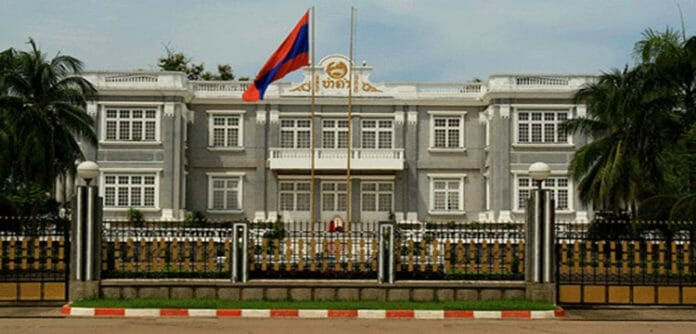FitchRatings has downgraded Laos’ Long-Term Foreign-Currency Issuer Default Rating (IDR) to ‘CCC-‘ from ‘CCC’ and the Country Ceiling at ‘B-‘. Fitch typically does not assign Outlooks to sovereigns with a rating of ‘CCC+’ or below. Fitch has removed the Long-Term IDRs from Under Criteria Observation (UCO).
The downgrade of Laos’ Long-Term Foreign-Currency IDR reflects a further rise in external liquidity risks, driven most recently by the spike in commodity prices and tightening global financing conditions. Its external debt repayment profile is challenging amid narrow financing options, surging inflation, currency depreciation and low foreign-exchange reserves. The Lao government has prioritised repayment of private debt obligations in recent years, but we believe risks are growing due to these external liquidity strains.
Intensifying External Liquidity Pressure: A higher import bill from the surge in global commodity prices and high debt repayments have driven up demand for foreign exchange amid increasingly scarce supply. This has resulted in a sharp depreciation of the Lao kip against the US dollar by almost 25% since February 2022 and 35% since last year at the official rate. Rates in the parallel market indicate even greater pressure, with the gap relative to the official rate widening to 25% in June. The authorities have taken steps that have stabilised the official rate since end-June, but expect some further depreciation in the remainder of 2022.
Foreign-exchange reserves have remained stable at around USD1.2 billion through March 2022, despite the building pressure on the currency. Nevertheless, reserve cover relative to imports (about 1.5 months of import cover) and external debt repayments is low. Fith forecasts foreign-exchange reserves to begin to decline towards USD900 million by end-2022.
Wider Current Account Deficit: Fitch forecasts the current account deficit to widen to 5% of GDP in 2022 from higher oil and other import prices. Higher export earnings, especially from the electricity sector, turned the current account to a surplus of 1.8% of GDP in 2021 per official statistics, the basis of our forecasts; the IMF estimates a 5% deficit in 2021 based on its assessment of an undercounting of imports under official statistics. Rising interest payments are adding to the deficit, but we expect strong export performance to keep the deficit contained at around 3.5% of GDP in 2023-2024.
Large External Debt Repayments: Laos has high external debt payments of USD1.2 billion-1.4 billion (principal and interest) per annum through 2026, with about USD300 million during the remainder of 2022. This includes a total of nearly USD1 billion equivalent in baht-denominated bond maturities in the Thai market (about half due in 2025) and USD760 million classified officially as commercial bank loans.
Limited External Financing Options: External financing options for the sovereign remain narrow. The sovereign successfully issued in the Thai market for the first time since 2019, raising nearly USD150 million equivalent in baht-denominated bonds in March 2022. However, market access in Thailand is likely to be constrained to rollovers of future baht-denominated maturities and could prove challenging amid tightening global market conditions. An issuance in international bond markets appears impossible. There are no indications that IMF financial support is being pursued.
The government has turned to domestic financing from the central bank and domestic banks. However, this source of financing is likely to be limited in light of the small size of the domestic market and could potentially exacerbate inflationary pressure.
Debt Relief from China: China remains a key source of bilateral financing and possible debt relief, as roughly half of Laos’s external debt and repayments in the coming years are due to China. Fitch estimates that Laos has already received around USD800 million in debt relief on a bilateral basis from China during 2020-2021. The nature of this relief is unclear, though it believes it is likely to be structured similarly to the G-20’s Debt Service Suspension Initiative, which involved payment deferments.
The ‘CCC-‘ Long-Term Foreign-Currency IDR also reflects the following factors:
Fiscal Deficit to Widen Modestly: Fitch expects the general government deficit to stagnate at around 3.2% of GDP in 2022-2024 after it narrowed to 1.4% in 2021. Expenditure compression drove much of the narrowing in 2021, but this will be difficult to sustain amid rising inflationary pressure. The firm forecasts a steady rise in interest payments over the next few years from about 11% of revenue in 2021 to about 20% by 2023 due to greater reliance on market financing and rising interest rates, constraining the sovereign’s fiscal flexibility. Low revenue collection, at around 14% of GDP, is a key challenge.
Government Debt Ratio Jumps: It forecasts Laos’ public and publicly guaranteed debt ratio will rise sharply to about 108% of GDP in 2022, well above the roughly 70% peer median, from 73% in 2020. The surge in the debt level is largely due to the significant depreciation of the Lao kip against the US dollar over the past couple of years given the large share of foreign-currency debt of about 90% of total debt.
Inflation Surges: The rise in global commodity prices and currency depreciation pushed inflation to a record 23.5% in June 2022, exacerbating economic stability risks. The rating firm forecasts inflation to remain elevated, averaging 18% in 2022. Inflation pressure should recede gradually from 2023, averaging 12%, on declining oil prices and base effects.
Near-Term Growth Slowdown: Fitch forecast GDP growth to slow to 2.0% in 2022 from 3.2% in 2021, as recent fuel shortages and surging inflation will weigh on growth prospects. Over the medium term, however it expects strong hydropower export performance, sustained FDI, the recent opening of the Lao-China railway, and the removal of pandemic-related border restrictions to support solid growth of around 4.5% in 2024 and beyond









